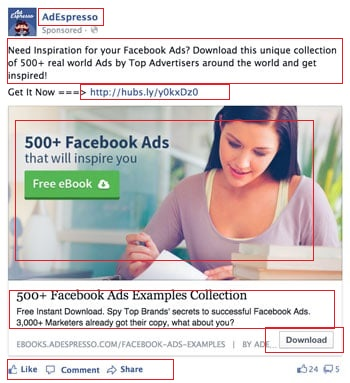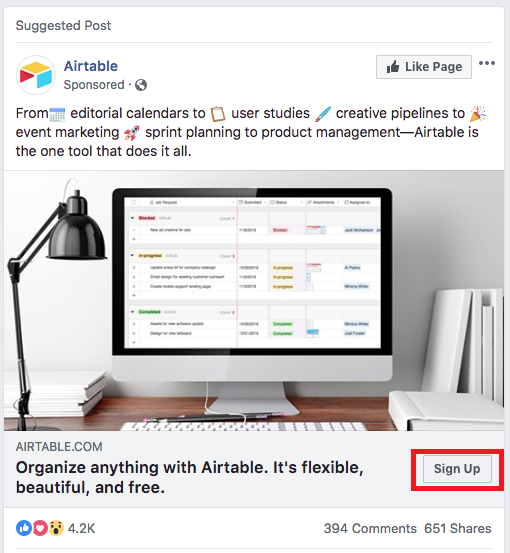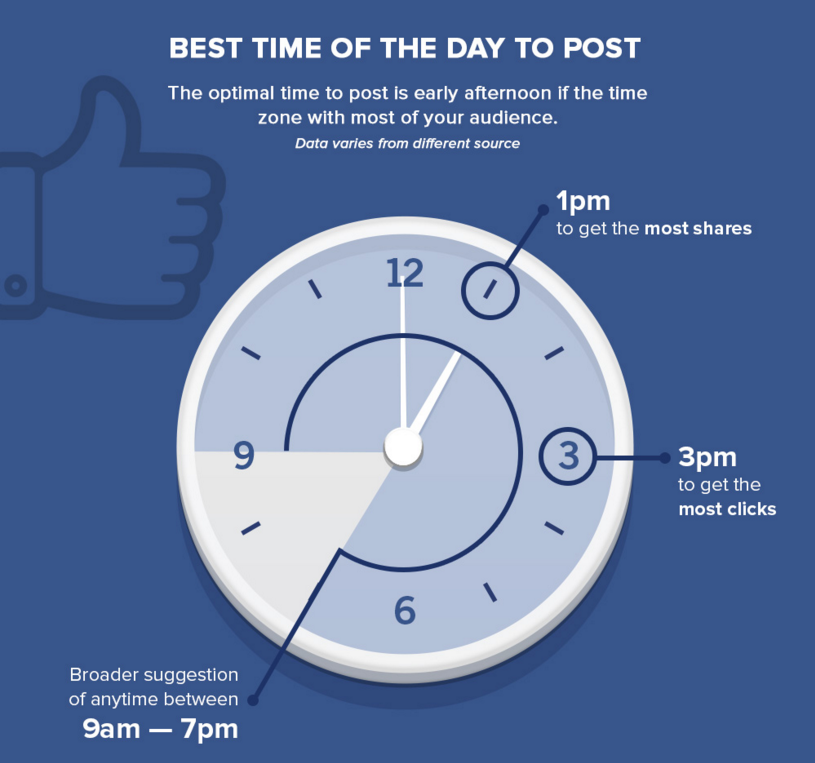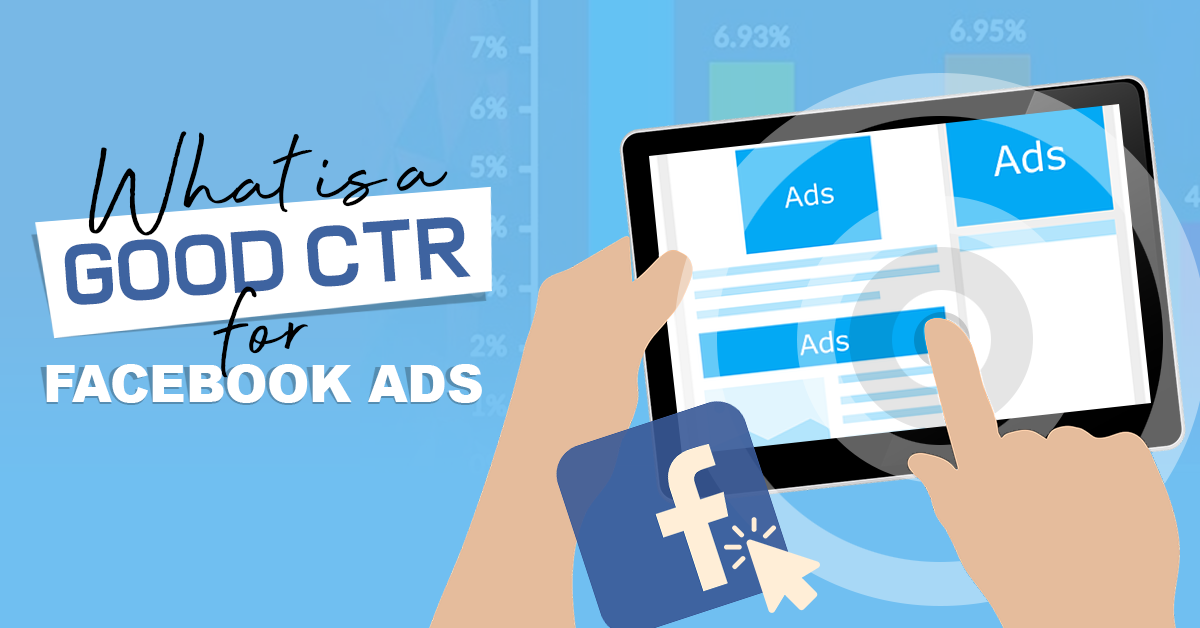For business owners or digital marketers running Facebook ads, a good CTR means your ads are working. Metrics vary from industry to industry, but this introductory guide will help you understand what’s a good CTR for your Facebook ads and how to increase your click-throughs.
If you’re even a little curious about Facebook ads, it’s likely this question has crossed your mind: how do I know they’re working?
Obviously, the first answer is something like, “well, if I’m making more than I’m spending…” but unfortunately, it’s not as simple as that. Sometimes you’re going to spend money without immediately and wholly making it back the next day, the next week, or even the next year. Sometimes you’re going to spend cash and not see an ROI for a long, long time.
Well isn’t that just peachy?
Fear not. We’re going to talk about one of the most effective ways to tell if your ads are working when you can’t use sales as a metric, and that’s the CTR, or Click-Through Rate.
So… What’s CTR Exactly?

Great question. As far as a basic definition, the name – click-through rate – kind of gives it away. It’s the number of people that click on your ad divided by the number of people who saw it. Then you multiply that number by 100 to get your CTR percentage.
When it comes to Facebook ads, the CTR is going to be the number of people who saw your ad anywhere on the site (protip: just run ads on the newsfeed) divided by the number of people who were served the ad. Easy enough, right?
This number is really, really important, and one of the first things you’re going to look at when you’re checking the performance of your ads. However, Facebook can’t make anything simple, so of course, there are a couple of different things you need to know about Facebook ad CTR specifically.
For more on running Facebook ads, the Facebook Side Hustle Course teaches you everything you need to know about running ads for small businesses. With just 2-3 hours of work per week, you can earn an extra $1,000-$1,500 per month.
Facebook CTR metrics
Facebook CTR metrics can be pretty complicated, but here are four of the most important things you need to know.
1. Don’t confuse CTR with link clicks or clicks
You might be tempted to look at clicks and think it’s your click-through rate because clicks = click through. That isn’t true. The Facebook link clicks or clicks takes ALL clicks into account, including likes, reactions, and shares. This is not a true CTR.
2. Know that Facebook will absolutely take your CTR rates into consideration
Facebook will bid on ad space for you, which means that you don’t have to select how much you want to pay per click – Facebook will figure it out, based on its own algorithms and a metric ton of data. However, its main goal is to make sure it serves relevant advertisements, and one of the things that attribute to your ad being relevant is your CTR.
Check out this pretty awesome study from AdEspresso that helps explain a little more about relevance scores and how CTR plays a HUGE part in them.
Relevance scores are based on a combination of Facebook’s most educated guess, feedback scores from users, and CTR.
The higher your relevance score, the more your ad will be served, and the higher the position it will be ranked on the newsfeed (or sidebar, etc). The more your ad is served at a higher position, the more people are going to see it (impressions). The more people see it, the more likely it is that you’re creating a valuable audience.
If it seems complicated, it is. As a bonus, Facebook is pretty consistently changing its rules from year to year in an effort to serve the best ads to the best audiences.
However, we’re pretty confident in saying that your click-through rate on Facebook ads is going to ALWAYS matter.
3. There are now two types of CTR that Facebook ads show
The first type of metric shown for CTR is CTR (all). This CTR represents the number of clicks in your ad AREA. Your ad area looks like this:

This CTR is actually pretty helpful for photo ads like this, but sometimes you really just want to know how many people clicked through on your link. Thus, there is also CTR (Link), which tracks how many people clicked on a link that took a user off-site.
So for this lovely Airtable ad, you can see there is a SINGLE place that would be counted on CTR (link) metrics.

If you want to know even more about the difference between these metrics, Facebook’s Ad Help Center is basically advice from the masters.
4. No one metric, even CTR, tells you the whole story of your ad.
You’ll need to look at several numbers to really get a sense of what’s going on, so don’t be surprised, or freak out, if your CTR varies some in one direction or the other. CTR is just the beginning – make sure you look at ALL of your metrics, not just this one.
What’s a good click-through rate for Facebook ads?
This probably isn’t going to be the answer you want to hear, but a good CTR for Facebooks ads will depend on your industry. BUT, if you look at all ads across all industries, the average CTR hovers right around .90%. Yes, that’s less than a 1% click-through rate.
Here’s a chart that breaks down the average CTR in a number of popular industries that use Facebook ads:
| Industry | Average CTR |
|---|---|
| Apparel | 1.24% |
| Auto | 0.80% |
| B2B | 0.78% |
| Beauty | 1.16% |
| Consumer Services | 0.62% |
| Education | 0.73% |
| Employment & Job Training | 0.47% |
| Finance & Insurance | 0.56% |
| Fitness | 1.01% |
| Home Improvement | 0.70% |
| Healthcare | 0.83% |
| Industrial Services | 0.71% |
| Legal | 1.61% |
| Real Estate | 0.99% |
| Retail | 1.59% |
| Technology | 1.04% |
| Travel & Hospitality | 0.90% |
Averages vs. real life CTRs
It may look painful, but remember, CTR is just ONE metric. A low CTR rate does not mean a bad ad, nor an unsuccessful one. However, it can be an indicator that some tweaks are necessary.
While the metric data isn’t separate currently, there is a difference between link, picture, and video CTRs. You can look at the data above and see some of this – beauty, for example, has over a 1% CTR because beauty pictures and videos are often gorgeous and engaging.
Your CTRs are going to vary a lot depending on the nature of the content, the quality of the content, and the overall appeal of the content. Some beauty products or retail product pages may have a MUCH higher CTR and some a much lower one, depending on the product, service, and whether you’re using a picture, video, or just a link. Even your copy can entirely change metrics (we talk about this a lot in our course, so let’s not repeat ourselves).
The biggest factors in your CTR for Facebook ads are going to be:
- Your niche/industry
- Your product/service
- Whether you’re using video, picture, status updates, etc.
- The quality of your video, picture, status updates, etc.
- The target audience (cold, retargeted, pixel traffic, from a mailing list, etc.)
If you’re doing ads for the niches above, however, and are above average – a little or a lot – count it as a success.
Or, decide that it isn’t good enough and blow the average right out of the water.
The choice is yours.
How to Increase Your CTR on Facebook
There are countless ways to improve ads – there’s nothing magical about testing, testing, testing and seeing what works best. However, testing can be kind of expensive and when you’re working with a limited budget, it makes sense that you might be a little gun shy about throwing money into the metaphorical wind.
You don’t get a pass on testing – that’s how you’re going to make your ads rock – but here are a couple of key places to start with testing if your CTR on your Facebook ads is low.
Your copy
People read ad copy! I know it might not seem like it, but they really do. Ad copy is going to make a huge, huge difference in the response of your audience. Changing a few words can completely flip your results.
What you write makes a difference. Just like changing the order of your words in a subject line for an email can double your open rate, changing the flow of your copy can do the same to your CTR.
Your creative (picture)
Most of us are going to use static images for ads because it’s easier and Facebook has a nice contract with a couple of stock photo companies. But, make sure you choose your picture well. If possible, run a few low-budget tests side-by-side and see which takes the lead in a few days. Even if that lead is only a handful of clicks, go with that one – a handful of clicks turns out to be quite the chunk over time.
Also, ensure your picture is relevant to your target audience. This might be obvious to you, but a lot of advertisers forget that certain styles appeal to certain groups. You’re not going to use a babe in an intense bathing suit to try and get middle-aged women to sign up for a fitness class, for example.
Your audience
There are so many ways to find audiences on Facebook it’s not even funny. If you’re using cold targeting, it’s easy to make tweaks to your audience demographics and see what works best.
Here as well, we recommend running 3-5 ads side-by-side with slightly different demographics (and no other changes) to see what really resonates. This can be tricky, but eventually the goal is to wind up with a “go-to” audience that you know will probably respond to a certain type of ad.
For lookalike audiences, you can refine by interests and age, and for fully custom audiences, you can still exclude people of a certain age group or demographic. Use your information wisely and to your advantage! The folks that will click are out there.
Time of day you post
There is some data out there that shows that even the time of day that you post is going to make a significant difference in your CTR. Facebook allows you to schedule your ads for a certain time, so you might as well take advantage.
Check out this chart we stole with love and permission from Jellymetrics:

It’s worth a shot and it doesn’t cost you anything to try different times, and it might make a huge difference.
The final word on a good CTR for Facebook ads…
In the end, a good CTR for a Facebook ad is well-established, but also varies based on industry, placement, quality, targeting, if you’ve sacrificed your first born to the appropriate entity…
We kid, of course. In the end, if your CTR is above industry standards, then you’re doing a pretty good job. If it isn’t, test. If it’s completely destroying the industry standard, then you keep on keeping on, because obviously you’ve found a unicorn and you should ride it off into the sunset as long as possible.


Leave a Reply